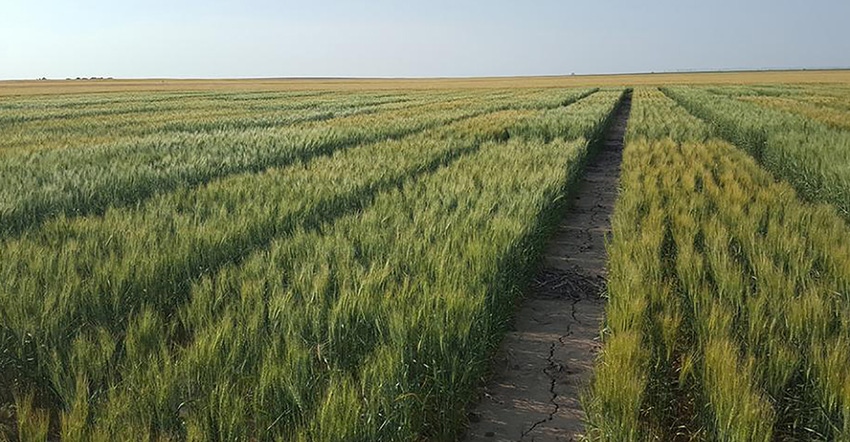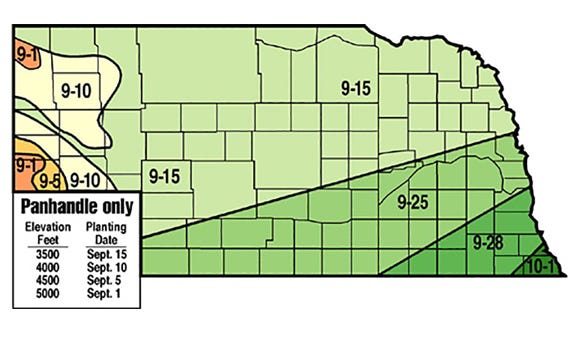September 14, 2018

By Bob Klein and Cody Creech
Winter wheat yield is affected by a range of production practices, pest management, fertility and weather. One production practice having a major impact on yield is seeding date.
Wheat seeded too early uses more soil water and nutrients in the fall, leaving less in the profile for yield production, and is more susceptible to insects and diseases. On the other hand, seeding too late reduces emergence, tillering and winter-hardiness.
The recommended seeding dates for Nebraska's winter wheat vary substantially from one end of the state to the other — from Sept. 1 in the extreme northwest to Oct. 1 in the southeast tip — and have been verified through years of research and farmer experience.
Some years an earlier seeding may have an advantage, and some years a later date may have an advantage. But in the long term, the suggested seeding dates will give the highest average yield.
Recent studies
Seeding date research funded in part by the Nebraska Wheat Board is underway in western Nebraska. Some of the initial results from 2018 are found in the accompanying table. The ideal seeding date for a given year depends on the environment and available moisture. In 2018, early seeding at both McCook and Sidney had greater yields than later seeding dates.

RECOMMENDED PLANTING DATES: The dates on the map are a guide rather than an absolute deadline. Each producer should make changes to ensure the planting dates fit the conditions of his or her farm. (Source: UNL CropWatch)

The opposite was true in 2017. Much of the early-seeded wheat in 2017 became infested with wheat streak mosaic virus because of the extended fall and warmer temperatures. In 2017, on-time seeding that followed the recommendations in the accompanying map performed the best. This research will be continued for another year before any changes are made to the current recommendations.
Tiller development
Date of seeding greatly affects development of tillers in winter wheat, the source of as much as 70% of the grain yield in a normal year. Seeding during the optimum period enables wheat to form sufficient but not excessive tillers. Early seeding results in too many fall tillers, which may compete with each other, become diseased and deplete soil moisture so that grain yields are low.
Late seeding gives plants little time to develop tillers, resulting in an inadequate numbers of spikes (heads) for high yields the following spring. When seeding late, the seeding rate should be increased to compensate for the reduced number of tillers. Also, fertilizer placed with or near the seed promotes plant development.
Senescence and death may eliminate excessive tillers that form during the fall. Conversely, if too few tillers develop during fall, additional tillers may form during spring; however, the yield potential may differ between tillers that develop during fall and those that develop during spring.
Tillering also enables the plant to adapt to different conditions. Few tillers develop when moisture, nutrition and other conditions are poor, whereas numerous tillers form when conditions are favorable. More tillers lead to increased yield potential.
The recommended seeding date represents a goal for seeding completion. As farm size and the number of acres increase for individual farmers, so does the length of time needed to complete seeding. The goal should be to have all wheat seeded by the ideal date. Plan your field order for planting accordingly. For example, plant higher elevation fields and those containing sandy soil first, and leave lower fields and those with higher clay content until last.
Recommended planting dates
Several factors were considered when developing the existing recommended seeding dates. In the Panhandle, the dates depend on elevation. Producers can determine the ideal date for each field by knowing the elevation. Using a starting point of Sept. 15 for 3,500 feet, one day should be added for each 100-foot decrease and subtracted for each 100-foot increase in elevation. For the rest of the state, Sept. 25 or later seeding dates are recommended to avoid Hessian fly infestation.
The map is a guide rather than an absolute deadline. Each producer should make changes to ensure the planting dates fit the conditions of his or her farm.
Fertilizer use
If the seeding date is delayed or growing conditions prevent or delay root growth to the dual placement fertilizer band, seed fertilizer placement is the preferred application method. Poor root growth for whatever reason limits root-fertilizer contact and tillering, which affects yield.
Disease problems
Delayed planting dates also may be due to a need to avoid wheat streak mosaic virus, Russian wheat aphid, crown and root rot, and too much fall growth. Excessive fall growth causes excessive moisture use and stress. There are several reasons for planting early.

SEEDING DATE: Above are seeding date results for three locations in 2018. Yield reported is bushel per acre. The Sidney late planting date was late-maturing and harvested late. Data has not been analyzed, but it is anticipated it will be around 50% of the on-time yield based on visual observations. (Source: UNL CropWatch)
One is to get adequate ground cover to avoid erosion from wind and water. Another is to get adequate plant growth to ensure winter-hardiness. A third reason is to quicken maturity the following summer and avoid excessive heat stress.
Planting date's effect on yield
A Kansas State University study to determine how seeding date affects tiller development and productivity of winter wheat was conducted in a corn-soybean rotation at Hutchinson, Kan. Two hard red winter wheat varieties, Jagger and 2137, were planted on four dates in the fall of 1995.
The first date, Sept. 28, was during the early part of the recommended period, Sept. 26 to Oct. 20. The second date, Oct. 11, was one day after the Hessian fly-free date, and the last two dates, Oct. 28 and Nov. 11, were after the recommended period.
Wheat varieties were planted at 60 pounds per acre of seed in plots. Plots received 70 pounds per acre of nitrogen and 25 pounds per acre of phosphorus before planting and 50 pounds per acre of nitrogen in late February 1996.
Data for Jagger and 2137 were pooled, since results for the two varieties were similar. Nearly equal numbers of seedlings emerged after all planting dates except Oct. 11, when considerably more plants emerged. Plants from the first two dates tillered profusely, developing most of their tillers before they became dormant in late fall. Plants from the latter two seedings did not form any tillers before they became dormant, but those from the Oct. 28 seeding developed a few tillers over winter.
Only 46% and 65% of the fall tillers on plants from the first two dates, respectively, survived the winter, whereas 100% of the fall tillers on plants from the last two dates survived. About 50% to 60% of the surviving fall tillers from the first two dates formed spikes, while approximately 80% of the surviving tillers from the last two dates produced grain.
Plants from the first three seeding dates developed nearly 600 spring tillers per square yard, but plants from the last date formed only 213 spring tillers per square yard. About 30% of the spring tillers from the first two dates, 45% of the spring tillers from the third date and 68% of the spring tillers from the fourth date produced grain.
The total number of productive spikes ranged from 260 to 552 per square yard, or 1.8 tillers per plant from the last seeding to three to four tillers per plant from the first seeding.
Klein is an Extension crops specialist in western Nebraska, and Creech is an Extension dryland cropping systems specialist. This report comes from UNL CropWatch.
You May Also Like




